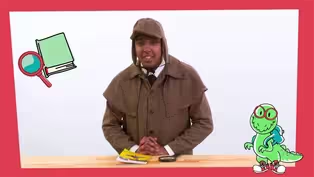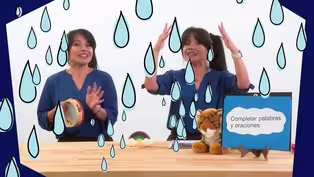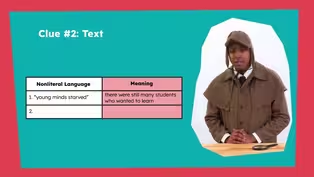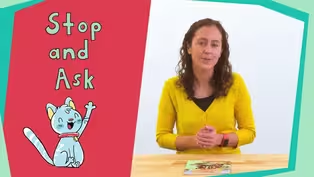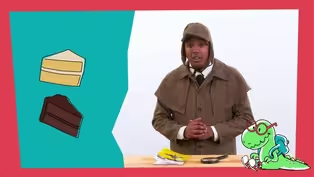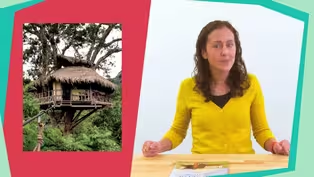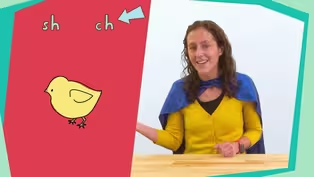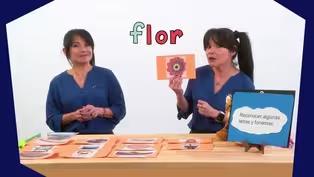
Episode 31 | Literacy Lessons
4/20/2021 | 28m 46sVideo has Closed Captions
Literacy lessons for early learners, led by NC teachers.
The first lesson (aimed at PreK-K learners) helps students understand that reading happens from left to right. The second lesson (aimed at 1st-2nd graders) helps learners use story elements to comprehend the story, “The Princess and the Pea.” Classroom Connection is your At-Home Learning companion where children love to learn. All lessons are led by NC educators.
Problems playing video? | Closed Captioning Feedback
Problems playing video? | Closed Captioning Feedback
At-Home Learning Presents: Classroom Connection is a local public television program presented by PBS NC

Episode 31 | Literacy Lessons
4/20/2021 | 28m 46sVideo has Closed Captions
The first lesson (aimed at PreK-K learners) helps students understand that reading happens from left to right. The second lesson (aimed at 1st-2nd graders) helps learners use story elements to comprehend the story, “The Princess and the Pea.” Classroom Connection is your At-Home Learning companion where children love to learn. All lessons are led by NC educators.
Problems playing video? | Closed Captioning Feedback
How to Watch At-Home Learning Presents: Classroom Connection
At-Home Learning Presents: Classroom Connection is available to stream on pbs.org and the free PBS App, available on iPhone, Apple TV, Android TV, Android smartphones, Amazon Fire TV, Amazon Fire Tablet, Roku, Samsung Smart TV, and Vizio.
Providing Support for PBS.org
Learn Moreabout PBS online sponsorshipMore from This Collection
Video has Closed Captions
Literacy lessons for early learners, led by NC teachers. (28m 46s)
Video has Closed Captions
Literacy lessons for early learners, led by NC teachers. (28m 46s)
Video has Closed Captions
Literacy lessons for early learners, led by NC teachers. (28m 45s)
Video has Closed Captions
Literacy lessons for early learners, led by NC teachers. (28m 45s)
Video has Closed Captions
Literacy lessons for early learners, led by NC teachers. (28m 46s)
Video has Closed Captions
Literacy lessons for early learners, led by NC teachers. (28m 46s)
Video has Closed Captions
Literacy lessons for early learners, led by NC teachers. (28m 45s)
Video has Closed Captions
Short Description: Literacy lessons for early learners, led by NC teachers. (28m 45s)
Video has Closed Captions
Literacy lessons for early learners, led by NC teachers. (28m 45s)
Video has Closed Captions
Literacy lessons for early learners, led by NC teachers. (28m 45s)
Video has Closed Captions
Literacy lessons for early learners, led by NC teachers. (28m 45s)
Video has Closed Captions
Literacy lessons for early learners, led by NC teachers. (28m 45s)
Providing Support for PBS.org
Learn Moreabout PBS online sponsorship[cheerful upbeat music] ♪ - Hi friends, welcome to another awesome day of Classroom Connection.
I'm Mr. R, and I'm so glad to see you today.
Did you know that this space right here, this space right here is magical?
Yeah it's true, and do you know why?
Because this is where learning happens, and learning is the most magical thing ever.
I love learning new things.
Do you?
I know you do.
Today is going to be so much fun, we're going to learn about reading as well as arts and science.
But mostly we're going to have some fun.
So let's jump in.
[bright upbeat music] - Hello, super learners, my name is Mrs. Jennifer, and I am so excited that you're here to learn with me today.
For today's lesson, you will need a stuffed animal, and the heart word cards we made last time.
Ask a trusted adult to help you find these items.
If you were not able to join me last time, I will share my heart work cards with you.
While you're grabbing your supplies, I'm gonna grab mine as well.
I'll be right back.
[bright upbeat music] All right, super learners, let's get started.
The last time we were together, we learned three heart words.
Those words were look, at, and the.
We're going to use these words to read some sentences today.
Let's review our words.
Here is our first word, look.
This word is, look, say it with me, look, tell your stuffed friend, the word.
Did you tell your friend look?
Great reading.
Now let's spell look.
Say the letters, l, o, o, k. Now, let's read the word, look, great.
Let's look at this word.
This word is at.
Say it with me, at.
Tell your stuff friend the word.
Did you tell your friend at?
Great reading.
Now let's spell at, a, t. Now let's read the word, at, great.
Now let's look at this word.
This is the word, the, say it with me, the.
Tell your stuffed friend the word.
Did you tell your friend the?
Great reading.
Now, let's spell the.
Say the letters with me, t, h, e. Now, let's read the word, the, great.
Super learners you did an awesome job reading and spelling our heart words look, at, and the.
I have some sentences that have our heart words in them.
Let's read them together.
Remember that when we read, we start with the words on the left and move to the right.
Let's read the words together while I point to them.
Then I want you to read them to your stuffed friend, while I point to the words.
Look at the cat.
Now read it to your stuffed friend.
[bright upbeat music] Great reading.
Now let's read this sentence, look at the pig.
Now read it to your stuffed friend.
[bright upbeat music] Great reading.
Look at the sheep.
Now let's read it to your stuffed friend.
[bright upbeat music] Great job.
Look at the hen.
Now, read it to your stuffed friend.
[bright upbeat music] Great reading.
Now let's read our last sentence.
Look at the kitten.
Now read it to your friend.
[bright upbeat music] Great job super learners, that was amazing reading.
You read five sentences using our heart words, look, at and the.
Now, let's get ready to read our book.
Our book is titled Animals Animals.
Remember that the title is the name of the book.
What do you think this book is about?
Tell your stuffed friend, what you think?
[bright upbeat music] I think this book is about different types of animals.
Making predictions about a book or guesses about what we will be learning is a great way to be a good reader.
Super learners, it helps us focus on what we will be reading.
Let's open our book and see if our predictions are correct.
[bright upbeat music] Look at the monkey.
Can you eat a banana like a monkey?
[chewing] [bright upbeat music] Look at the lion.
Can you bore like a lion?
[roaring] Look at the giraffe.
Can you stretch your neck to eat leaves like a giraffe?
[eating] Look at the bear.
Can you growl like a bear?
[growling] [bright upbeat music] Look at the snake.
Can you slither and hiss like a snake?
[hissing] Look at the zebra.
Can you eat grass like a zebra?
[eating] [bright upbeat music] Look at the animals.
Which animal is your favorite?
Whisper it to your stuffed friend.
[bright upbeat music] I like all these animals, but my favorite is the monkey because I liked to eat bananas too.
Wow, super learners, we've already made it to the end of our lesson.
Thank you so much for being with me today.
As we practice reading and spelling our heart words, look, at and the.
Beyond the lookout for these heart words as you go about your day.
I hope you enjoyed acting like the animals in our story.
See you next time.
- These are some friends of mine who know animals like really really know animals.
I'm so excited to see what they're getting into today.
Let's watch.
- Target, good job.
[bright upbeat music] - When we talk about training animals, a lot of people get the impression that we train the animals to do tricks, but here at the North Carolina Zoo, it's a completely different story.
[bright upbeat music] - We work with our animals with positive reinforcement based training.
And what this is is we get the animals to cooperate in their daily care by reinforcing the behaviors that we would like for the animals to do.
- What I do is have her nose target my hand.
I want her to just be as still as possible.
- Third taking Kelly for a walk, and sometimes she goes where she shouldn't go.
So we have this target stick.
Kelly target, good job.
Training is one of the most rewarding parts of our job because it really helps us build positive relationships with an animal.
An animal looks forward to seeing us when we come, they trust us and therefore it's just a wonderful partnership between us as the keepers and the animals.
- Kelly.
- [ Narrator] The trust and bond between the keepers and the animals is very important and also absolutely necessary in several ways.
For example, by building a strong trust, many medical checkups and procedures can be performed by the trainers or when necessary prepare the animals for procedures that would require the attention of the zoo veterinarian.
- The keepers will, which you oftentimes don't see is they're training the animals to participate in their own health care.
- [Narrator] Kelly, the Cape porcupine is being trained to participate in a sailing flush of her mouth, using a syringe.
This is done to prevent an infection after tooth extraction.
And in a different part of the park Twix Tokudu is getting trained to handle needles.
- Hold, poke, good girl.
And so my thing is, what I'm working on is slowly just getting more and more pressure.
So when she actually does get a blood draw it won't be new to her.
- [Narrator] Taking a blood sample is not always the easiest thing to do but important in order to understand the health of the animals.
Through training Twix is learning to stand still and allow the trainers to practice the blood draw.
Similarly, the red river hog is trained to allow the trainer to examine her and to get on the scale when it's time to measure the weight.
The appreciated belly scratch is the reinforcer for the behavior, but for some of the animals basic medical procedures, like this could become more than difficult if it wasn't for this type of training - Take Nick, for example, Nick is a large male polar bear.
We don't wanna do anesthesia every year because there's a risk associated with all anesthetic procedures.
So if we can get blood from him without having to put him under anesthesia, Hey, that's good for me, it's good for him.
Meth is not an animal you want to be in there with.
He is 1200 pounds of pure muscle.
- [Narrator] The polar bears have been trained to participate in all kinds of examinations, like presenting their paws, stand up straight in such things as allowing the keepers to take a blood sample when necessary.
Procedures that without training would otherwise have required anesthesia.
And besides daily care and medical examinations behavioral training also has educational importance allowing visitors to the zoo a chance to meet some of the zoo animals up close.
These Conures are trained to voluntarily kennel so they can be taken to various locations around the park to interact with guests.
- We like to inspire visitors to be more passionate about birds, also educate them.
I enjoy just the moment of all people see when they see the birds come out and fly and we take it for granted the cool things we get to see every day.
But people really got new appreciation for birds when they see them in an area that would be like their natural habitat.
And I also love it when the kids participate in getting to inspire that.
- Training is all about choice.
The keepers can ask an animal to do a behavior and if the animal chooses to do the behavior they get rewarded for it.
If they choose not to do the behavior, nothing happens.
So it doesn't take out of that trust bank at all - Who knew about all that incredible science?
Oh, you did?
Well of course you did because you are smart.
But did you know this?
What is the fastest animal on the planet?
Yup, it can be on land, the water or in the air.
If you said cheetah, you're almost right.
Cheetahs are the fastest land animal.
The fastest animal on the whole planet is the Peregrine Falcon, capable of flying over 200 miles per hour.
Watch out.
[bright upbeat music] - Hello readers, my name is Ms. Gary, and I'm so excited to be learning with you today.
Before we get started with our learning, I'm gonna say hello to you with a welcome song.
♪ Hello readers, hello readers, ♪ ♪ how are you?
♪ ♪ How are you?
♪ ♪ I'm so glad to see you.
♪ ♪ I'm so glad to teach you.
♪ ♪ Hello you, you and you.
♪ I have a question for you readers.
Why is reading so important?
Think about that.
And then tell me your answer.
Those are great answers.
Reading is important because it allows us to learn about and understand the world around us.
It also helps us to understand the stories that we're reading or listening to.
Today, we're going to read a book, and learn how to use all of our really great reading skills to help us ask and answer questions about the text.
Today while we're learning together, we're going to need a couple things.
I need you to grab something to write with, and a piece of paper that you can fold and write on.
So go grab yours quickly and I'll grab mine and I'll be right back.
[bright upbeat music] I'm back readers, I have my paper, and my pen to write with.
If you have a crayon or a marker or even a pencil that's okay.
So good readers ask questions about the text.
They ask questions before, during and after they read it.
So we're going to make a graphic organizer together and this is gonna help us organize our questions about the text before, during, and after we read it.
So take your piece of paper and you're gonna fold it into three parts, kind of like a taco or a burrito.
So I'm gonna fold it so that it has three parts.
So now my paper has three parts, one, two three.
In the top box you are going to write before just like you see on my chart right there.
This is going to be where we, look at the pictures or think about what the title means, or ask questions that we're curious about before we start reading.
Good readers will also ask questions while they're reading, or during their reading time.
This is the time where they can predict what they think is going to happen.
And today we're gonna do that while we're listening to our story.
So you've can write the word during in the middle part of our chart, just like I have here.
And in our last part of our organizer we're gonna write the word after because readers help check their understanding or comprehension after they've finished reading.
So write the word after, just like you see here on your graphic organizer.
So I want you to raise your hand.
Tell me if you think you're a good reader, raise it high so I can see it.
That's awesome.
I think you're a good reader too.
So let's get started with our story today.
Today, we're going to be reading a fairytale called the Princess and the Pea.
It's retold by Sarah Mitchell and it's illustrated by Sandra Camille.
Remember a fairy tale is a story that was told long ago and has a lesson.
So let's look at the cover of our story.
What do you think is happening here?
Well, I see the title is the princess but doesn't a princess often wear a Tiara and have really fancy clothes on?
The girl on the cover of this story, the doesn't look too fancy.
So I'm wondering what will this story be about?
I'm gonna write a question down and stick it on my before I start reading section.
Good readers ask questions before?
So why don't you write down your question?
Take just a moment and put that in the before reading section of your graphic organizer.
Do you wanna read me your question?
Those are all really great questions.
Now let's get started with our reading.
The Princess and the Pea.
Once there was a prince who wanted to get married but he wanted to find a real princess.
So the prince went back to look for one but he couldn't find her.
Get all those different princesses.
[bright upbeat music] So the prince went back home.
The prince was sad.
He wanted to find a real princess.
Remember readers, good readers will ask questions while they're reading.
So I'm wondering, will he ever find a princess?
I don't know.
Let's look here.
There's another question that I thought of there's someone at the door, but who's at the door?
Let's write down a question to stick in our second box, during reading.
Here's my question, who's at the door?
[bright upbeat music] Let's keep reading to find out.
One night there was a big storm.
Rain fell from the sky.
There was a knock at the door.
The King opened the door.
There stood a young woman.
She was sopping wet from head to toe.
What's the word sopping mean?
Look at that picture.
She's soaking wet, that's what sopping means.
"I'm a princess, may I stay here for the night?"
Said the woman.
The King and queen looked at the woman.
Her hair was wet.
Her shoes were wet.
Her dress was caked in mud.
She did not look like a real princess but the King and queen asked her to come in.
I wonder what the word caked means.
Doesn't look like she has a cake on?
Oh, she was caked in mud meaning she was covered in mud.
Do you have a question for this page also?
If you do, go ahead and write your question down.
I'm wondering a lot of things too.
[bright upbeat music] I wonder if she's really a princess.
Do you think if she is, they'll introduce her to the prince?
Maybe that's a question that you write down on your graphic organizer.
Let's keep reading.
Was she a real princess?
The queen wanted to find out.
She came up with the test.
The queen put a tiny pea at the bottom of the bed.
Then she put 20 mattresses on top of that pea.
Then she added 20 more.
"Now we will see if she's a real princess", said the queen.
I'm wondering again while I'm reading, good readers ask questions while they read.
I'm wondering why did she put a pea underneath those mattresses?
I'm gonna put that question down on my deering reading.
Do you have something you're wondering about?
If so, go ahead and write it down.
Let's keep reading.
[bright upbeat music] That night, the woman didn't sleep.
She didn't sleep a wink.
The next day the woman said, "I didn't sleep a wink.
There was a lump in my bed.
It hurt my smooth soft princess skin."
The queen said, "you passed my test."
You are a real princess.
You felt that tiny pea under 40 mattresses, and it hurt your skin.
Only a real princess has such soft skin.
The prince shall marry you.
So the prince and princess got married, and the tiny pea is still under glass.
Wasn't that an entertaining fairytale friends?
Not your typical princess story, and that's why I love it so much.
So let's think how the pea helped the prince find a princess.
Our learning goal today was to ask and answer questions that determine our understanding of the text.
To do this, we ask questions before we started reading, we stopped and asked questions while we were reading, and now we're going to ask questions for after our reading.
So, who were the characters in our story?
Do you remember?
That's right.
The prince, the princess, the King and queen.
But what was the prince looking for?
Can you tell me?
Yeah, he was looking for a princess.
He didn't seem to be having very much look though but then there was a knock at the door.
So who was knocking?
I'll show you to help you remember.
It was the sopping wet girl.
She was knocking at the door and from the looks of her did the King and queen believe she was a real princess?
No, and why not?
Because she didn't look like princesses normally look with tiaras and fancy clothes she was caked in mud.
So what did the queen do to help us find out if she was really a princess?
Do you remember?
She put a tiny pea underneath 40 mattresses and no one but a real princess with delicate skin would ever be able to feel that.
So did the sopping wet girl pass the queens test?
She did because the book told us, she didn't sleep a wink.
She could not sleep because she could feel that tiny pea lump and it was hurting her soft, delicate skin.
So the girl was really a princess.
And at the end, she got to marry the prince.
What do you think the fairytales lesson is after listening to it?
It's that you shouldn't jump to conclusions about how someone looks and you shouldn't judge a book by its cover.
So readers, you did great work today asking and answering questions before, during and after our reading.
This is a strategy that all good readers do.
So I hope you enjoyed this story and the lesson, and I'll see you all next time.
Bye readers.
[bright upbeat music] - Oh, geez, geez.
Hold on, hold on.
Hello, hey, this just in, we got a really cool video headed straight for us.
- [Woman] How to animate with sticky notes.
Here's one I did earlier of a frog.
You can see, you can just flip through all the pictures and it looks like he's moving.
You're gonna need sticky notes, something to draw with, and some creativity.
Here's a UFO I drew gliding through the air.
[bright upbeat music] So first you're gonna need your blank, sticky note pad, and you're gonna wanna go to the last page of the book.
Draw something nice and dark there so that be able to see it on the next page.
[bright upbeat music] I always like to draw a couple images and just trace over them in one spot.
So the viewer knows what to expect as the flip books flip very quickly.
So I'm just gonna go ahead here and start drawing each picture.
I'm gonna be drawing a classic bouncing ball going up and down.
[bright upbeat music] Let's see it squashes is on the ground, and starts flying back up, [bright upbeat music] and then I'm almost done just a couple more, and now let's flip.
[bright upbeat music] Perfect.
[bright upbeat music] And if you have any tape on hand.
I always like to tape the spine of my book in case I wanna add or take out pictures.
I can always just tape it back together and keep it really strong and flip.
[bright upbeat music] - Wow what a great lesson.
I love reading so much.
I feel like I learned something new each time.
Do you?
I bet you do.
I can already see your brain looks bigger than it did before the lesson or did you just do something different with your hair?
Either way you look as smart.
[cheerful upbeat music] ♪
Support for PBS provided by:
At-Home Learning Presents: Classroom Connection is a local public television program presented by PBS NC
